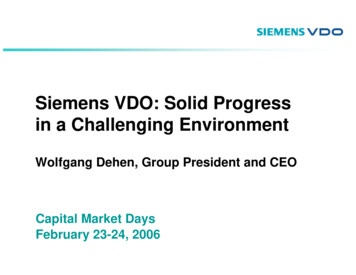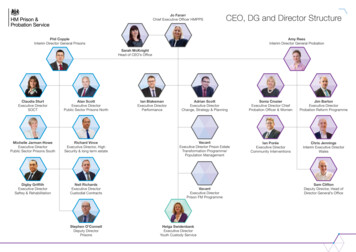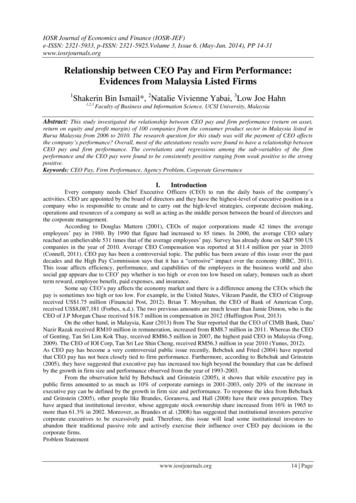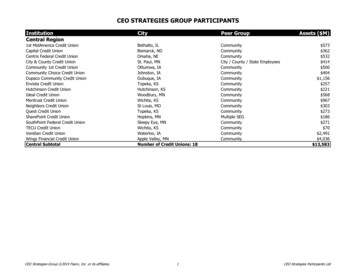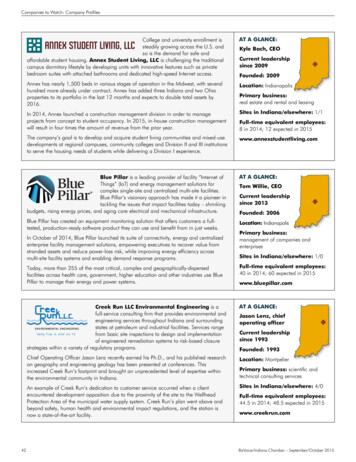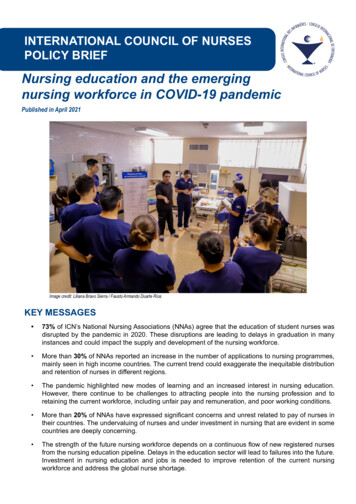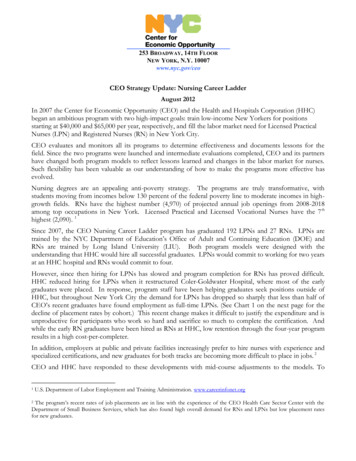
Transcription
CEO Strategy Update: Nursing Career LadderAugust 2012In 2007 the Center for Economic Opportunity (CEO) and the Health and Hospitals Corporation (HHC)began an ambitious program with two high-impact goals: train low-income New Yorkers for positionsstarting at 40,000 and 65,000 per year, respectively, and fill the labor market need for Licensed PracticalNurses (LPN) and Registered Nurses (RN) in New York City.CEO evaluates and monitors all its programs to determine effectiveness and documents lessons for thefield. Since the two programs were launched and intermediate evaluations completed, CEO and its partnershave changed both program models to reflect lessons learned and changes in the labor market for nurses.Such flexibility has been valuable as our understanding of how to make the programs more effective hasevolved.Nursing degrees are an appealing anti-poverty strategy. The programs are truly transformative, withstudents moving from incomes below 130 percent of the federal poverty line to moderate incomes in highgrowth fields. RNs have the highest number (4,970) of projected annual job openings from 2008-2018among top occupations in New York. Licensed Practical and Licensed Vocational Nurses have the 7 thhighest (2,090). 1Since 2007, the CEO Nursing Career Ladder program has graduated 192 LPNs and 27 RNs. LPNs aretrained by the NYC Department of Education’s Office of Adult and Continuing Education (DOE) andRNs are trained by Long Island University (LIU). Both program models were designed with theunderstanding that HHC would hire all successful graduates. LPNs would commit to working for two yearsat an HHC hospital and RNs would commit to four.However, since then hiring for LPNs has slowed and program completion for RNs has proved difficult.HHC reduced hiring for LPNs when it restructured Coler-Goldwater Hospital, where most of the earlygraduates were placed. In response, program staff have been helping graduates seek positions outside ofHHC, but throughout New York City the demand for LPNs has dropped so sharply that less than half ofCEO’s recent graduates have found employment as full-time LPNs. (See Chart 1 on the next page for thedecline of placement rates by cohort.) This recent change makes it difficult to justify the expenditure and isunproductive for participants who work so hard and sacrifice so much to complete the certification. Andwhile the early RN graduates have been hired as RNs at HHC, low retention through the four-year programresults in a high cost-per-completer.In addition, employers at public and private facilities increasingly prefer to hire nurses with experience andspecialized certifications, and new graduates for both tracks are becoming more difficult to place in jobs. 2CEO and HHC have responded to these developments with mid-course adjustments to the models. To1U.S. Department of Labor Employment and Training Administration. www.careerinfonet.orgThe program’s recent rates of job placements are in line with the experience of the CEO Health Care Sector Center with theDepartment of Small Business Services, which has also found high overall demand for RNs and LPNs but low placement ratesfor new graduates.2
address the low placement rate for LPNs, HHC developed a pilot program for graduates to work asresidents at its hospitals. In this program CEO supports LPN graduates that have not been placed in jobsthrough a six-week orientation at two hospitals. Upon completion of the orientation, they become parttime employees of the hospital and work hours that would otherwise be covered by LPNs earning overtime.This helps new graduates gain work experience and reduces overtime costs for HHC. The chart belowshows that the residency program has employed 40 percent (33 of 79) of 2010 and 2011 graduates whileonly 40 percent (24 of 79) have gained employment as full-time LPNs.Chart 1: Outcomes for CEO Nursing Career Ladder-LPN Program as of May lemental HHC Residency ProgramNumber of Graduates ParticipatingNANA122133808Number of GraduatesNumber Earned LPN LicenseNumber of Job PlacementsNumber of Participants Hired Full Time orGiven More Hours2008393232NANAIt also shows that, in the program’s first two years, 80 percent of graduates gained employment as LPNs.Of those 68 jobs, 42 (60 percent) were at HHC’s Coler-Goldwater Hospital in long-term care. While theresidency program is an innovative response the hiring problem, it is a shift from the original model, inwhich participants were expected to gain full-time employment at HHC after one year of training.Job placement has not been a challenge for early graduates of the RN program, but the program has hadlow student retention because participants entered while they were in their pre-clinical phase of studies andmost did not advance through the completion of the four-year degree. In addition to all that CEO and itspartners know about the challenges of college completion and long training programs, we also learned thatmany students who identify early as nursing majors do not necessarily have a clear understanding of theacademic and clinical (i.e. technical, physical, and emotional) requirements of the profession. Of the 145who enrolled in the program between 2007 and 2009, 60 percent (87) did not complete the pre-clinicalphase. 3 In 2009 CEO and HHC determined that the program could not afford to invest in students untilthey had demonstrated a commitment to and aptitude for nursing. The program stopped recruitment atthat time so that CEO and HHC could assess if retention improved once students arrived at the clinicalphase.As of July 2012, retention through the clinical phase has been stronger, with 70 percent of those whoentered (58) having either graduated or remain enrolled. LIU reports an overall two- year retention rate of46 percent for its non-CEO students. CEO asked Metis Associates to conduct an interim evaluation in2010, the evaluators predicted this higher outcome:Given that the CEO Nursing Career Ladder RN Program students enter the LIU program with a slightly higherGPA than the average LIU student (3.0 vs. 2.75), and that HHC is providing a retention support servicesSee CEO Nursing Career Ladder RN Program: Program Review, Metis Associates. 2010 for data on reasons students leftthe program and other analyses.32
program4 for clinical program students, it might be expected that the retention rate for CEO Nursing CareerLadder RN clinical program students would remain at approximately 70% throughout completion of the two yearprogram. RN Interim Evaluation. Metis Associates 2010.The program seems to be performing as anticipated through the clinical phase. This suggests that the modelcould be less costly while still effective if it is designed to support students only after they have completedpre-clinical work. However, the evaluation report also identifies the trade-offs of admitting only moreaccomplished students, which can have a ‘creaming’ effect though still targets low-income students. As wecollect and analyze more data on program completers, we will continue to adjust the program model so thatit strikes the right balance between fulfilling our responsibility to invest public dollars effectively andachieving our goal of providing transformative opportunities to New Yorkers in need.Next Steps: FY13Despite the challenges described, it remains true that nursing jobs are expected to be high-demand positionsin a growing sector that offers a boost out of poverty. CEO’s evaluations (see attached) of both programsshow high student satisfaction and that they are reaching the target population of low-income New Yorkers.In FY13 CEO will maintain its annual 1.3 million investment in nursing, but will again adjust the programmodel.Given the current reductions in hiring and market preference for nurses with experience and more advanceddegrees, in FY13 the program design will shift to support fewer LPNs and more RNs. CEO will support 20new LPNs instead of 40, and will support 20 of our previous LPN graduates through the completion of aone-year accelerated RN associate’s degree at Helene Fuld College of Nursing. This will reduce the numberof new LPN graduates entering the field at a time of lower demand while supporting previous graduates inearning an advanced degree. It should also result in higher rates of RN retention by enrolling students whohave already successfully completed some clinical coursework as LPNs into an associate’s degree programthat is faster than a bachelor’s degree in nursing.Furthermore, reducing slots in the LPN program rather than eliminating it will allow for a rapid revivalwhen and if appropriate. There are indications that the current slowdown is only temporary, and HHC andprivate health care providers will resume hiring LPNs at higher rates as demand and capacity for long-termcare increases. Therefore CEO, HHC, and the NYC Department of Education (whose Department ofAdult and Continuing Education provides the LPN training through an agreement with CEO and HHC)want to maintain the Nursing Career Ladder LPN program so that it could be expanded again when themarket improves.In 2013 CEO will assess rates of retention and job placements for the Nursing Career Ladder program andmake recommendations for FY14 at that time.Kate DempseyDirector of Budget and OperationsCarson Hicks, Ph.D.Director of Programs and EvaluationThe retention support services program is funded by 500,000 in annual funding received as a grant from the Health Resourcesand Services Administration (HRSA).43
July 2010Participant Feedback on theNYC CEO Licensed PracticalNurse ProgramSUBMITTED TO:NEW YORK CITY CENTER FOR ECONOMICOPPORTUNITY1
2010 CEO Response to Participant Feedback on the NYC CEO Licensed Practical NurseProgramCEO created its Licensed Practical Nurse (LPN) Program in 2007 in partnership with the NYCDepartment of Education and the Health and Hospitals Corporation. The goal of the CEO LPNprogram is to raise the living standards of low-income individuals by providing them with trainingand support to become LPNs – a career projected to offer good wages and future growth.CEO knows from performance data that the program has a very high graduation rate and that thisrate is comparable to similar outcomes reported by DOE for its non-CEO LPN cohorts (in whichparticipants are not required to meet income eligibility criteria and are responsible for their owntuition). The small size of the program limits options for more rigorous evaluation. To informprogram assessment, CEO charged its external evaluators, Westat and Metis Associates, to collectfeedback from LPN students and graduates to learn about their experiences. Participant feedbackhas helped CEO understand better the program’s perceived value among its target population as itplanned next steps.Often a struggle with long-term training programs, this like other LPN programs has highgraduation rates. However, HHC’s hiring of LPNs has slowed since 2009. But while the recessionhas dampened the market, experts still contend that projections for the health care field anddemographic trends support long-term opportunities for LPNs and RNs. CEO and its partnerscontinue to analyze labor market data to determine projected growth for these particular positions.The report captures participants’ perceptions of the LPN program and their recommendations forimprovement. As developments in health care may present new opportunities to fund training andeducation for jobs, the report has informed CEO’s strategic planning around health care sectorworkforce development.FindingsMetis collected feedback from current students and graduates. The students participated in focusgroups and graduates completed a written survey.Overall, participants expressed high satisfaction with the program. Students appreciated the freetuition and other supports and the guaranteed employment after graduation. They also praised theteachers and high quality of instruction.Participants cited some challenges they experienced in the program, such as: financial difficultywhile studying full time, difficulty acclimating to the workplace, and personal and family stresses.2
RecommendationsMetis makes five recommendations based on the main challenges identified by students. CEOreviewed each with HHC and DOE. Below is a summary of CEO’s responses and next steps.1.Consider enhancing and expanding hands-on clinical experiences. HHC and DOE are exploringenhancements to the Transition to Practice (clinical) portion of the program. (Significantchanges to the curriculum require State approval.) To help graduates gain experience postgraduation, HHC created an LPN Residency program in which recent graduates work parttime at two HHC facilities. This program has the added benefit of reducing overtime coststhat the facilities would otherwise pay to full-time staff.2.Explore recognition of the LPN program by CUNY for those graduates seeking to pursue an RN degree.CEO is working with DOE and CUNY to explore an articulation agreement.3.Consider providing a monthly stipend to program participants.CEO provides free tuition, books,materials, and staff support, and agrees that the financial challenges experienced byparticipants enrolled in a full time program are real. To address additional needs, HHCstaff are available to assist students in securing supports such as public benefits throughoutthe duration of the program. The program does achieve a 98% graduation rate, so thesesupports appear to encourage program completion. All partners continue to look foradditional ways to support students.4.Consider providing an on-site counselor/social worker to address participants’ personal and family stresses.HHC and DOE are working to identify sources of social work counseling services, such asinterns from nearby colleges. HHC support staff include two counselors who are availableto work with students regarding any challenges they experience.5.Consider providing additional support to LPN graduates. Regarding support for the licensingexam: The pass rate for the NCLEX-PN licensing exam was 82% for the first cohort and97% for the second cohort. It seems that students are sufficiently prepared to take theexam. The program offers a prep course to all students and will continue to do so.Regarding support in the workplace: Program staff are aware that graduates experience difficultyacclimating to the workplace. HHC has begun working with its Office of Corporate Recruiting tointegrate job readiness training into the curriculum.Kate DempseyDirector of Budget and OperationsCarson Hicks, Ph.D.Director of Programs and Evaluation3
Graduates’ Feedback on the NYC CEO Licensed Practical Nurse ProgramJuly 2010IntroductionThe NYC Center for Economic Opportunity (CEO) has funded approximately 40 initiatives acrosssome 20 sponsoring agencies aimed at reducing the number of working poor, young adults, andchildren living in poverty in New York City. CEO is committed to evaluating its programs andpolicies and is developing a specific evaluation plan for each of its initiatives. For example, severalmajor new initiatives will implement random assignment evaluations or other rigorous designs.Some programs are slated to receive implementation and outcome evaluations, while others may beevaluated using readily available administrative data. This differentiated approach reflects the variedscale of the CEO interventions, data and evaluation opportunities, and finite program andevaluation resources. Westat and Metis Associates are evaluating many of these programs on behalfof CEO. The purposes of the evaluations are to collect and report data on the implementation,progress, and outcomes of the programs in the CEO initiative to inform policy and programdecision-making within CEO and the agencies that sponsor the programs.CEO supports several workforce development programs that focus on health care careers includingthe Licensed Practical Nurse program, a Registered Nurse Training program, and a health caresector center that trains and places job seekers in a variety of health professions.1This brief describes the qualitative assessment conducted by Metis Associates of the LicensedPractical Nurse (LPN) program. Metis Associates gathered feedback from participants as theycompleted the program and from graduates more than a year after completing the program. CEOsought to learn more about whether participants felt adequately prepared by the program,suggestions for improvement, and how they fared in the workplace. Metis collected data from focusgroups and a survey.Metis conducted two focus group sessions with Licensed Practical Nursing (LPN) programparticipants in June 2009. Participants had concluded their 11-month program and were gettingready to graduate. The LPN program started in 2007; the participants for the focus group sessionsrepresent the second program cohort. The focus group sessions were attended by 38 of the 39program participants. The sessions were held at the program site – The Coler-Goldwater Hospitalat Roosevelt Island in New York City. Participants received two movie tickets as an incentive forparticipating in the focus group sessions. The focus group sessions aimed to uncover information inthree main areas: participants’ motivation for enrolling in and completing the program; satisfactionwith the program; and plans for the future. The focus group Interview Guide is included asAppendix A.In November-December 2009, Metis also conducted a survey of the first LPN program cohort.This group had completed their training in June 2008 and had been in the workforce forapproximately 18 months. First cohort LPN graduates were offered a 30 gift card for filling outthe survey which was available online as well as in hard copy. In spite of outreach from LPN1See www.nyc.gov/ceo for more information.4
program staff, a total of only 13 out of 40 LPN graduates participated in the survey, for a responserate of 32.5%. The survey is included as Appendix B.Program DescriptionThe CEO-sponsored LPN program at the Coler-Goldwater Specialty Hospital and Nursing Facilitylocated on Roosevelt Island, New York, is a collaboration between the Health and HospitalsCorporation (HHC) and the New York City (NYC) Department of Education (DOE). There werealready two existing DOE LPN programs in Brooklyn and Manhattan, and each recruitsapproximately 60 students annually. The CEO-sponsored HHC/DOE LPN program recruits about40 students annually who meet income eligibility criteria. (The non-CEO cohorts in Brooklyn andManhattan do not have income eligibility criteria.) Recruitment and preparation for the CEOprogram began in February 2007 and classes began in September 2007. The State EducationDepartment Office of Post Secondary Programs and Office of Professions have approved thecurriculum for this program, and DOE is responsible for implementing it.The goal of the CEO LPN program is to raise the living standards of low-income individuals byproviding them with training and support to become licensed practical nurses (LPNs) – a career thatis projected to offer good wages and future growth. With the LPN credential, individuals can earn astarting HHC salary of approximately 40,000 per year.The program receives approximately 1 million in funding from CEO and can accommodate up to40 students. The program is an accelerated LPN program and students complete the program inless than one year, compared to a more traditional two-year model. Participants in the CEOprogram must be at or under 130% of poverty unless they are HHC employees. HHC wasinterested in developing a career ladder for its employees and had a private grant funding thatallowed employees to receive their salaries while in the training program. In the first program year,10 of the 40 students were HHC employees; in the second year without the additional grant sixHHC employees participated and 34 slots were allocated
Sep 30, 2009 · LIU reports an overall two- year retention rate of 46 percent for its non-CEO students. CEO asked Metis Associates to conduct an interim evaluation in 2010, the evaluators predicted this higher outcome: Given that the CEO Nursing Career Ladder RN Program students ente

